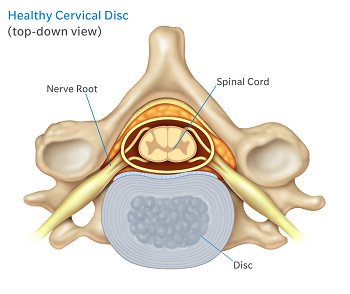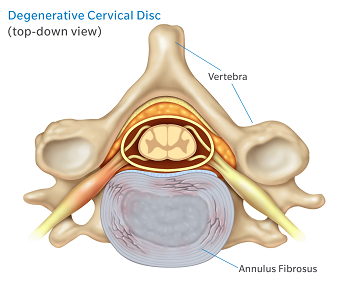In the healthy neck, there is a disc filled with fluid between each bony element of the spine (vertebra). The disc helps to cushion the vertebrae from moving together under the weight of the head. Degeneration of the spine can start from over-use, an accident, or just the wear and tear of everyday life.
When a disc degenerates (breaks down), the disc:
- Loses water: with less water, the disc becomes thinner and has less padding to absorb movement. The disc may become less flexible.
- Shrinks: The shrinking disc can narrow the space available for the nerve roots and spinal cord.
- Tears/Cracks: the disc can have tiny tears or cracks in its outer layer (annulus fibrosus). If the outer ring of the disc fully tears or splits, the gel-like center can squeeze out.
As the disc deteriorates, the vertebrae may also begin to break down or touch.


What are symptoms of degenerative disc disease?
Depending on the amount of degeneration, patients with degenerative disc disease experience varied levels of pain, less neck motion, and weakness in the arms and hands. Not all disc degeneration results in pain or lack of mobility.
Disc degeneration can cause the:
- Inner disc (nucleus pulposus) to squeeze through the outer disc (disc bulge or disc herniation).
- Spinal canal to narrow and pinch the cord and nerves (spinal canal stenosis).
- Spinal cord to be irritated causing a loss of feeling or movement (myelopathy).
- Nerve roots to be irritated or pinched causing pain, weakness, or tingling down the arm and possibly into the hands (radiculopathy).